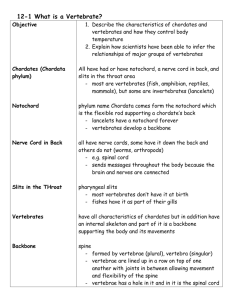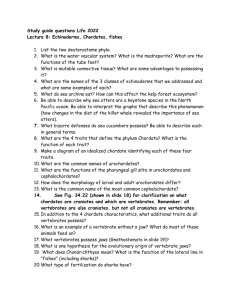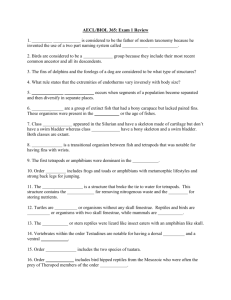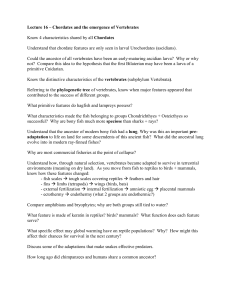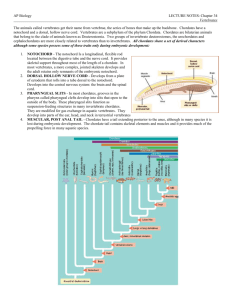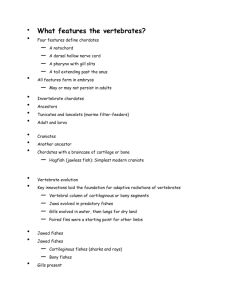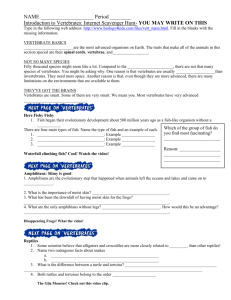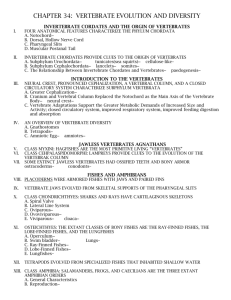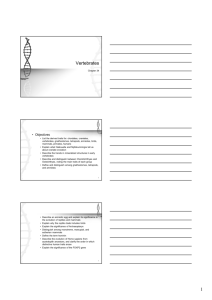• Ch 34 • Origin & Evolution of Vertebrates • Chordates • Chordates
advertisement
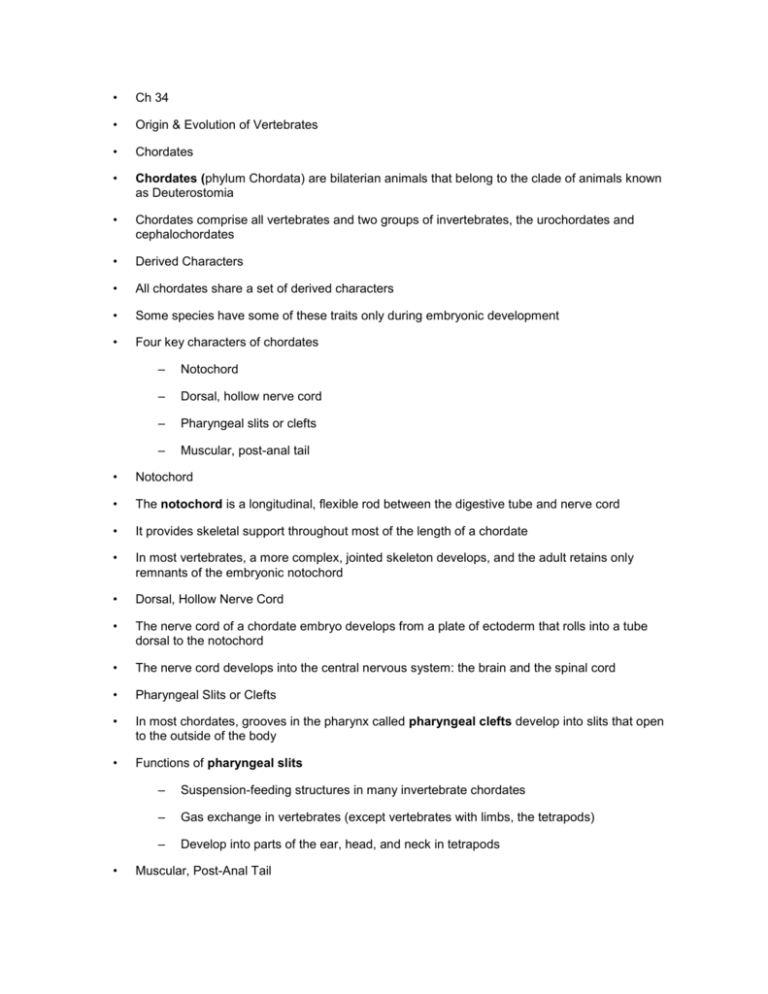
• Ch 34 • Origin & Evolution of Vertebrates • Chordates • Chordates (phylum Chordata) are bilaterian animals that belong to the clade of animals known as Deuterostomia • Chordates comprise all vertebrates and two groups of invertebrates, the urochordates and cephalochordates • Derived Characters • All chordates share a set of derived characters • Some species have some of these traits only during embryonic development • Four key characters of chordates – Notochord – Dorsal, hollow nerve cord – Pharyngeal slits or clefts – Muscular, post-anal tail • Notochord • The notochord is a longitudinal, flexible rod between the digestive tube and nerve cord • It provides skeletal support throughout most of the length of a chordate • In most vertebrates, a more complex, jointed skeleton develops, and the adult retains only remnants of the embryonic notochord • Dorsal, Hollow Nerve Cord • The nerve cord of a chordate embryo develops from a plate of ectoderm that rolls into a tube dorsal to the notochord • The nerve cord develops into the central nervous system: the brain and the spinal cord • Pharyngeal Slits or Clefts • In most chordates, grooves in the pharynx called pharyngeal clefts develop into slits that open to the outside of the body • Functions of pharyngeal slits • – Suspension-feeding structures in many invertebrate chordates – Gas exchange in vertebrates (except vertebrates with limbs, the tetrapods) – Develop into parts of the ear, head, and neck in tetrapods Muscular, Post-Anal Tail • Chordates have a tail posterior to the anus • In many species, the tail is greatly reduced during embryonic development • The tail contains skeletal elements and muscles • It provides propelling force in many aquatic species • Lancelets • Lancelets (Cephalochordata) are named for their bladelike shape • They are marine suspension feeders that retain characteristics of the chordate body plan as adults • Tunicates (Urochordata) are more closely related to other chordates than are lancelets • Trunicates most resemble chordates during their larval stage, which may last only a few minutes • As an adult, a tunicate draws in water through an incurrent siphon, filtering food particles • When attacked, trunicates, or “sea squirts,” shoot water through their excurrent siphon • Craniates • The origin of a head enabled chordates to coordinate more complex movement and feeding behaviors • Craniates share some characteristics: a skull, brain, eyes, and other sensory organs • Craniates have two clusters of Hox genes; lancelets and tunicates have only one cluster • One feature unique to craniates is the neural crest, a collection of cells near the dorsal margins of the closing neural tube in an embryo • Neural crest cells give rise to a variety of structures, including some of the bones and cartilage of the skull • Hagfishes • The most basal group of craniates is Myxini, the hagfishes • Hagfishes have a cartilaginous skull and axial rod of cartilage derived from the notochord, but lack jaws and vertebrae • They have a small brain, eyes, ears, and tooth-like formations • Hagfishes are marine; most are bottom-dwelling scavengers • Lampreys • Lampreys (Petromyzontida) represent the oldest living lineage of vertebrates • They are jawless vertebrates that feed by clamping their mouth onto a live fish • They inhabit various marine and freshwater habitats • They have cartilaginous segments surrounding the notochord and arching partly over the nerve cord • Origins of Bone & Teeth • Mineralization appears to have originated with vertebrate mouthparts • The vertebrate endoskeleton became fully mineralized much later • Today, jawed vertebrates, or gnathostomes, outnumber jawless vertebrates • Gnathostomes include sharks and their relatives, ray-finned fishes, lobe-finned fishes, amphibians, reptiles (including birds), and mammals • Chondrichthyans (Sharks, Rays, & Relatives) • Chondrichthyans (Chondrichthyes) have a skeleton composed primarily of cartilage • The largest and most diverse group of chondrichthyans includes the sharks, rays, and skates • Sharks have a streamlined body and are swift swimmers • The largest sharks are suspension feeders, but most are carnivores • Sharks have a short digestive tract; a ridge called the spiral valve to increase the digestive surface area • Sharks have acute senses including sight, smell, and the ability to detect electrical fields from nearby animals • Shark eggs are fertilized internally but embryos can develop in different ways – Oviparous: Eggs hatch outside the mother’s body – Ovoviviparous: The embryo develops within the uterus and is nourished by the egg yolk – Viviparous: The embryo develops within the uterus and is nourished through a yolk sac placenta from the mother’s blood • The reproductive tract, excretory system, and digestive tract empty into a common cloaca • Ray & Lobe finned fishes • The vast majority of vertebrates belong to a clade of gnathostomes called Osteichthyes • Nearly all living osteichthyans have a bony endoskeleton • Osteichthyans includes the bony fish and tetrapods • Aquatic osteichthyans are the vertebrates we informally call fishes • Most fishes breathe by drawing water over gills protected by an operculum • Fishes control their buoyancy with an air sac known as a swim bladder • Fishes have a lateral line system • Most species are oviparous, but some have internal fertilization and birthing • Ray-finned • Actinopterygii, the ray-finned fishes, includes nearly all the familiar aquatic osteichthyans • Ray-finned fishes originated during the Silurian period (444 to 416 million years ago) • The fins, supported mainly by long, flexible rays, are modified for maneuvering, defense, and other functions • Lobe-fins • The lobe-fins (Sarcopterygii) have muscular pelvic and pectoral fins • Lobe-fins also originated in the Silurian period • Three lineages survive and include coelacanths, lungfishes, and tetrapods • Coelacanths were thought to have become extinct 75 million years ago, but a living coelacanth was caught off the coast of South Africa in 1938 • Tetrapods • Tetrapods have some specific adaptations – Four limbs, and feet with digits – A neck, which allows separate movement of the head – Fusion of the pelvic girdle to the backbone – The absence of gills (except some aquatic species) – Ears for detecting airborne sounds • Origin of Tetrapods • Tiktaalik, nicknamed a “fishapod,” shows both fish and tetrapod characteristics • It had – Fins, gills, lungs, and scales – Ribs to breathe air and support its body – A neck – Fins with the bone pattern of a tetrapod limb • Amphibians • Amphibians (class Amphibia) are represented by about 6,150 species • Order Urodela includes salamanders, which have tails • Amphibian means “both ways of life,” referring to the metamorphosis of an aquatic larva into a terrestrial adult • Most amphibians have moist skin that complements the lungs in gas exchange • Fertilization is external in most species, and the eggs require a moist environment • In some species, males or females care for the eggs on their back, in their mouth, or in their stomach • Amniotes • Amniotes are a group of tetrapods whose living members are the reptiles, including birds, and mammals • Amniotes are named for the major derived character of the clade, the amniotic egg, which contains membranes that protect the embryo • The extraembryonic membranes are the amnion, chorion, yolk sac, and allantois • The amniotic eggs of most reptiles and some mammals have a shell • Amniotes have other terrestrial adaptations, such as relatively impermeable skin and the ability to use the rib cage to ventilate the lungs • Living amphibians and amniotes split from a common ancestor about 350 million years ago • Early amniotes were more tolerant of dry conditions than early tetrapods • The earliest amniotes were small predators with sharp teeth and long jaws • Reptiles • The reptile clade includes the tuataras, lizards, snakes, turtles, crocodilians, birds, and the extinct dinosaurs • Reptiles have scales that create a waterproof barrier • Most reptiles lay shelled eggs on land • – Most reptiles are ectothermic, absorbing external heat as the main source of body heat – Birds are endothermic, capable of keeping the body warm through metabolism – The oldest reptilian fossils date to the Carboniferous period The first major group to emerge were parareptiles, which were mostly large, stocky quadrupedal herbivores Lepidosaurs • One surviving lineage of lepidosaurs is represented by two species of lizard-like reptiles called tuataras • The other major living lineage of lepidosaurs consists of the squamates, the lizards and snakes • Lizards are the most numerous and diverse reptiles, apart from birds • Snakes are legless lepidosaurs that evolved from lizards • Snakes are carnivorous; some are also venomous • Turtles • All turtles have a boxlike shell made of upper and lower shields that are fused to the vertebrae, clavicles, and ribs • Some turtles have adapted to deserts and others live entirely in ponds and rivers • Gators & Crocs • Crocodilians (alligators and crocodiles) belong to an archosaur lineage that dates back to the late Triassic • Birds • Birds are archosaurs, but almost every feature of their reptilian anatomy has undergone modification in their adaptation to flight • Many characters of birds are adaptations that facilitate flight • The major adaptation is wings with keratin feathers • Other adaptations include lack of a urinary bladder, females with only one ovary, small gonads, and loss of teeth • Origins of Birds • Birds probably descended from small theropods, a group of carnivorous dinosaurs • Early feathers might have evolved for insulation, camouflage, or courtship display • Early feathers might have helped dinosaurs – Gain lift when they jumped – Gain traction running up hills – Glide from trees • By 150 million years ago, feathered theropods had evolved into birds • Archaeopteryx remains the oldest bird known • Living birds belong to the clade Neornithes • Several groups of birds are flightless – The ratites, order Struthioniformes – Penguins, order Sphenisciformes – Certain species of rails, ducks, and pigeons • Mammals – hair & milk production • Mammals, class Mammalia, are represented by more than 5,300 species • Mammals have – Mammary glands, which produce milk – Hair – A high metabolic rate, due to endothermy – A larger brain than other vertebrates of equivalent size – Differentiated teeth • Mammals evolved from synapsids • Two bones that formerly made up the jaw joint were incorporated into the mammalian middle ear • Monotremes • Monotremes are a small group of egg-laying mammals consisting of echidnas and the platypus • Marsupials • Marsupials include opossums, kangaroos, and koalas • The embryo develops within a placenta in the mother’s uterus • A marsupial is born very early in its development • It completes its embryonic development while nursing in a maternal pouch called a marsupium • In Australia, convergent evolution has resulted in a diversity of marsupials that resemble the eutherians in other parts of the world • Eutherians – Placental Mammals • Compared with marsupials, eutherians have a more complex placenta • Young eutherians complete their embryonic development within a uterus, joined to the mother by the placenta • Molecular and morphological data give conflicting dates on the diversification of eutherians • Primates • The mammalian order Primates includes lemurs, tarsiers, monkeys, and apes • Humans are members of the ape group • Most primates have hands and feet adapted for grasping, and flat nails • – A large brain and short jaws – Forward-looking eyes close together on the face, providing depth perception – Complex social behavior and parental care – A fully opposable thumb (in monkeys and apes) – Living Primates There are three main groups of living primates – Lemurs, lorises, and pottos – Tarsiers – Anthropoids (monkeys and apes) – The oldest known anthropoid fossils, about 45 million years old, indicate that tarsiers are more closely related to anthropoids than to lemurs – The first monkeys evolved in the Old World (Africa and Asia) • In the New World (South America), monkeys first appeared roughly 25 million years ago • New World and Old World monkeys underwent separate adaptive radiations during their many millions of years of separation • The other group of anthropoids consists of primates informally called apes • This group includes gibbons, orangutans, gorillas, chimpanzees, bonobos, and humans • Apes diverged from Old World monkeys about 20–25 million years ago • The species Homo sapiens is about 200,000 years old, which is very young, considering that life has existed on Earth for at least 3.5 billion years • A number of characters distinguish humans from other apes • – Upright posture and bipedal locomotion – Larger brains capable of language, symbolic thought, artistic expression, the manufacture and use of complex tools – Reduced jawbones and jaw muscles – Shorter digestive tract – Misconception: Early hominins were chimpanzees – Correction: Hominins and chimpanzees shared a common ancestor Misconception: Human evolution is like a ladder leading directly to Homo sapiens – Correction: Hominin evolution included many branches or coexisting species, though only humans survive today • Australopiths • Australopiths are a paraphyletic assemblage of hominins living between 4 and 2 million years ago • Some species, such as Australopithecus afarensis walked fully erect • “Robust” australopiths had sturdy skulls and powerful jaws • “Gracile” australopiths were more slender and had lighter jaws • Hominins began to walk long distances on two legs about 1.9 million years ago • The oldest evidence of tool use, cut marks on animal bones, is 2.5 million years old • The earliest fossils placed in our genus Homo are those of Homo habilis, ranging in age from about 2.4 to 1.6 million years • Stone tools have been found with H. habilis, giving this species its name, which means “handy man” • Homo ergaster was the first fully bipedal, large-brained hominid • The species existed between 1.9 and 1.5 million years ago • Homo ergaster shows a significant decrease in sexual dimorphism (a size difference between sexes) compared with its ancestors • Homo erectus originated in Africa by 1.8 million years ago • It was the first hominin to leave Africa • Neanderthals, Homo neanderthalensis, lived in Europe and the Near East from 350,000 to 28,000 years ago • They were thick-boned with a larger brain, they buried their dead, and they made hunting tools • Debate is ongoing about the extent to which genetic material was exchanged between neanderthals and Homo sapiens • Homo sapiens appeared in Africa by 195,000 years ago • All living humans are descended from these African ancestors • The oldest fossils of Homo sapiens outside Africa date back about 115,000 years and are from the Middle East • Humans first arrived in the New World sometime before 15,000 years ago • In 2004, 18,000-year-old fossils were found in Indonesia, and a new small hominin was named: Homo floresiensis
